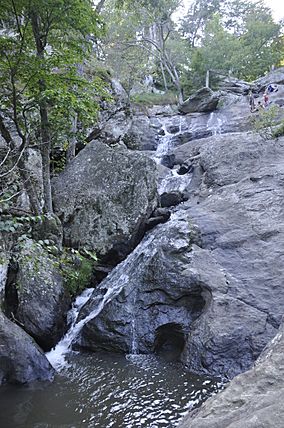Cunningham Falls State Park facts for kids
Quick facts for kids Cunningham Falls State Park |
|
|---|---|
|
IUCN Category V (Protected Landscape/Seascape)
|
|

The longest cascading waterfall in Maryland
|
|
| Location | Frederick County, Maryland, United States |
| Nearest town | Thurmont, Maryland |
| Area | 6,080 acres (24.6 km2) |
| Elevation | 1,247 ft (380 m) |
| Designation | Maryland state park |
| Established | 1954 |
| Administrator | Maryland Department of Natural Resources |
| Website | Cunningham Falls State Park |
Cunningham Falls State Park is a fun outdoor area in Maryland, United States. It's located west of Thurmont. This state park is famous for Cunningham Falls, which is the biggest waterfall in Maryland. It also has a large man-made lake and old ruins from an iron furnace. The park is part of the long Catoctin Mountain. It is next to Catoctin Mountain Park to the north.
Contents
Park History
Long ago, Native Americans lived in the Catoctin Mountain area. They hunted and fished there. They also dug up a type of rock called rhyolite to make tools.
Later, in the 1800s, settlers started cutting down trees. They used the wood to make charcoal. This charcoal powered the Catoctin Iron Furnace. You can still see "charcoal flats" in the park. These are flat, square areas where charcoal kilns were built.
For over 200 years, the forest was heavily used. By the 1930s, much of the land was damaged. The government bought the land to help it recover. Starting in 1935, workers from programs like the Works Progress Administration (WPA) and the Civilian Conservation Corps (CCC) helped. They worked to turn the area into a place for people to enjoy nature.
In 1954, the southern part of this land became Cunningham Falls State Park. It covers about 5,000 acres.
What You Can See
Cunningham Falls
The park's main attraction is Cunningham Falls. It is 78 feet tall! Locals used to call it McAfee Falls. It was later named after a photographer who took many pictures of the falls.
Old Buildings and Mines
You can find an old homestead above the falls. This was once a family home. There are also ruins of an old iron furnace. This furnace was built in the 1850s. You can also find an abandoned iron mine in the park.
Things to Do
Cunningham Falls State Park offers many fun activities. You can go hiking on trails. Hunting is allowed in certain areas. Swimming and boating are popular activities on the lake. Fishing is also a favorite pastime. Big Hunting Creek flows through the park. It is known as one of Maryland's best streams for trout fishing. Camping is also available for those who want to stay overnight.
Images for kids



